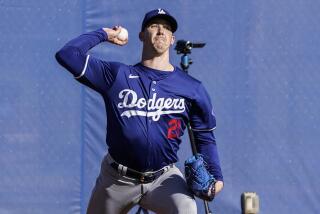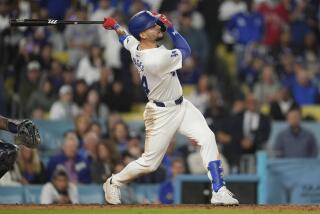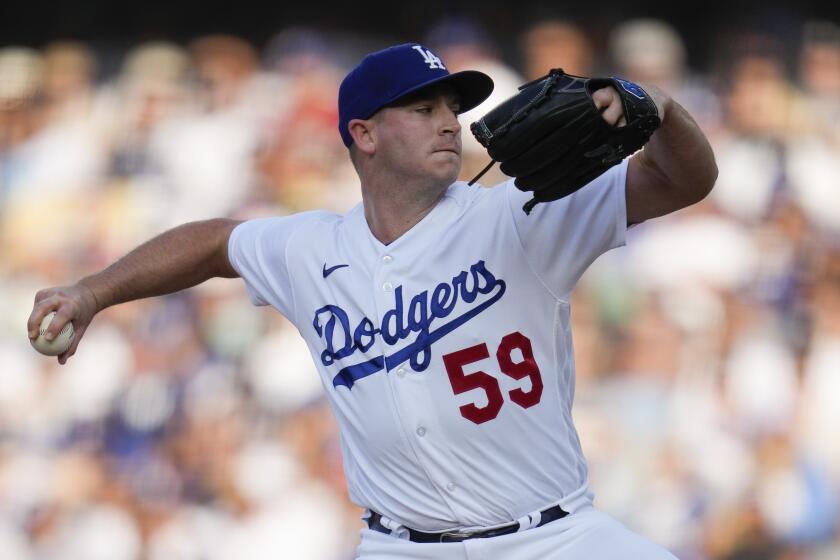Orlando Hudson gives Dodgers a big hand
Dodgers trainer Stan Conte says he has seen the videos several times, sometimes in slow motion. Each time, Conte says, he is left scratching his head.
The videos are of Orlando Hudson playing second base.
“I don’t know how he does it,” Conte said.
Hudson, who can barely bend back the hand connected to his surgically repaired left wrist, is regularly making the two plays that Conte was certain he would never make in a Dodgers uniform: the extended backhand on grounders up the middle and the diving catch to the left.
Conte says he has found himself telling Hudson, “I’ve seen the X-rays. You can’t do what you just did.”
But Conte is the first to say that medicine isn’t an exact science, that not everything in medicine can be explained by X-rays and records.
Sometimes, he said, you have to gamble.
Consider the risk. Look at the upside. Weigh that against the cost.
That was what the Dodgers did when they signed Hudson in February.
And they have been rewarded.
Hudson has played in 60 of the Dodgers’ 61 games. He was the only player to start the first 54.
He is hitting .308 with four home runs, 17 doubles and 34 runs batted in, and could be headed to the All-Star game in St. Louis on July 14.
“It’s beyond my wildest expectations he’s doing what he’s doing,” assistant general manager Logan White said.
Conte doesn’t disagree.
Hudson’s ability to do what he has done with an inflexible glove is a credit to his athleticism, particularly his foot speed, the trainer said.
“He’s such a great athlete that he made these corrections very quickly and naturally,” Conte explained. “Typically, we talk about compensation being a bad thing. In his case it was a good thing.”
The Dodgers were well aware of how Hudson dislocated his wrist playing for the Arizona Diamondbacks last August. And, like the other teams that asked to see his medical records, they knew that his wrist would never fully recover.
Hudson didn’t deny this. He still isn’t denying it.
“It’s not going to change,” he said. “It’s not going to change next month. It’s not going to change when I’m 85.”
The player who turned down an offer for a reported four-year, $29-million contract extension from the Diamondbacks was relegated to looking for a one-year, incentive-laden deal in the off-season.
Even at the sharp discount, the three-time Gold Glove Award winner and former All-Star had trouble finding takers. So in January, Hudson came to L.A. and worked out at Pepperdine in front of Dodgers GM Ned Colletti, Colletti assistant Rick Regazzo, White and Conte.
Workouts like these are rarely observed by both baseball and medical personnel, but this was a rare case. Conte said he had uncovered no records of any baseball player returning from such an injury.
The first workout raised concerns.
“His timing was off fielding and hitting,” White said.
Conte was even less sold.
“My assessment was that his range of motion and strength was very down,” he said.
Conte’s recommendation to Colletti: Don’t sign him.
But Conte didn’t shut the door, telling Colletti he would like to monitor Hudson’s progression if he remained unsigned long enough for that to be possible.
It was.
Early in spring training, Colletti told Conte and White to fly to Houston. They were to watch Hudson work out again.
They watched Hudson hit at an indoor facility, then went to a local high school to watch him field.
They had to climb the fence to get in, prompting Conte to say, “Hey, he passed the first test.”
What White and Conte saw on the field was promising.
White saw Hudson make adjustments that let him field balls with what was essentially an immobile wrist.
And there was something else.
“I saw a guy who wasn’t bitter over the big contract he lost,” White said. “I think a lesser makeup guy wouldn’t have recovered to the extent that he has.”
Conte said he saw signs of progress from the medical side.
While Hudson’s wrist had failed to gain any mobility, it had gained a significant amount of strength. And the fact that Hudson wasn’t feeling any pain was a sign to Conte that the bone in his wrist had stabilized.
There were reservations, however.
Conte estimated that there was an 80%-90% chance that Hudson would land on the 60-day disabled list early in the season.
White feared that Hudson, then a career .282 hitter, would return as a .240 or .250 hitter.
Still, they had one message for Colletti: Considering the upside, it’s worth it if you can sign him at a reasonable price.
Colletti sealed the deal with Hudson for only $3.38 million. The guaranteed one-year deal included another $4.62 million based on plate appearances.
The Dodgers’ expectations were modest.
“I don’t think any of us really believed he would be ready on opening day,” Colletti said. “If it would’ve been April 20 or April 25, we wouldn’t have been surprised.”
Manager Joe Torre said he went so far as to tell Blake DeWitt -- who was penciled in to be the Dodgers’ starting second baseman before Hudson was signed -- to be prepared to play on opening day.
Only one person seemed sure he would be ready for the start of the season and that was Hudson.
How could he be so sure?
“I have a bigger doctor upstairs,” he said.
--
--
BEGIN TEXT OF INFOBOX
Who’s on second?
Davey Lopes’ last season with the Dodgers was 1981. The opening day starters at second base since:
*--* 2009: Hudson 2008: Kent 2007: Kent 2006: Kent 2005: Kent 2004: Cora 2003: J. Cabrera 2002: Grudzielanek 2001: Grudzielanek 2000: Grudzielanek 1999: Young 1998: Young 1997: W. Guerrero 1996: DeShields *--*
*--* 1995: DeShields 1994: DeShields 1993: Reed 1992: Samuel 1991: Samuel 1990: Randolph 1989: Randolph 1988: Sax 1987: Sax 1986: Sax 1985: Duncan 1984: Sax 1983: Sax 1982: Sax *--*
Source: Los Angeles Times
More to Read
Are you a true-blue fan?
Get our Dodgers Dugout newsletter for insights, news and much more.
You may occasionally receive promotional content from the Los Angeles Times.






